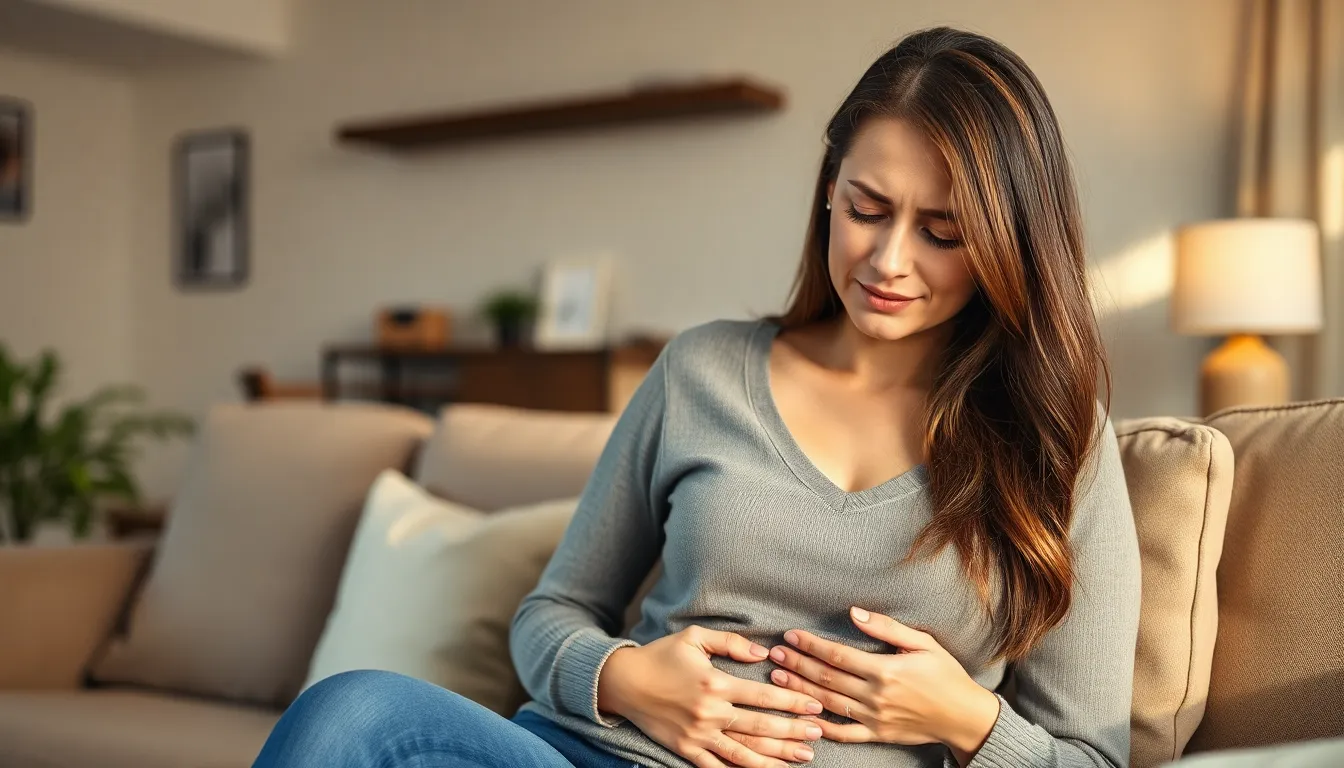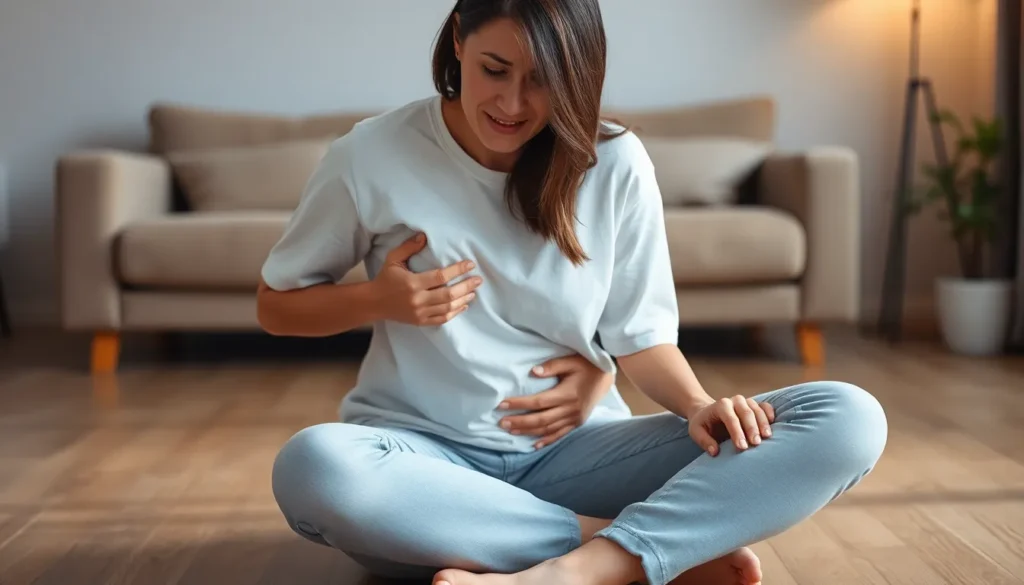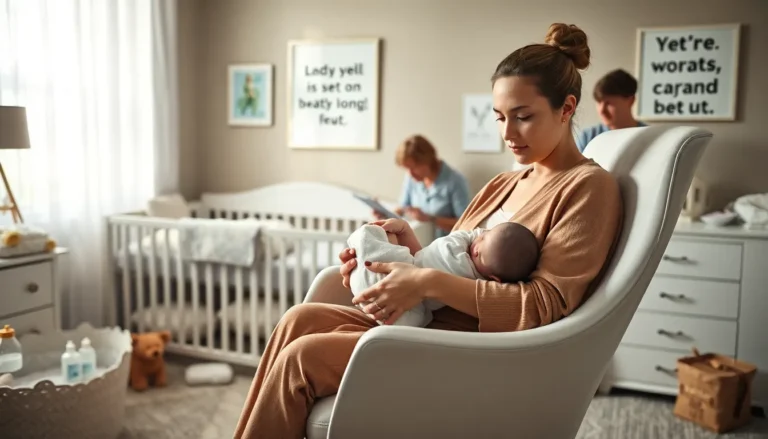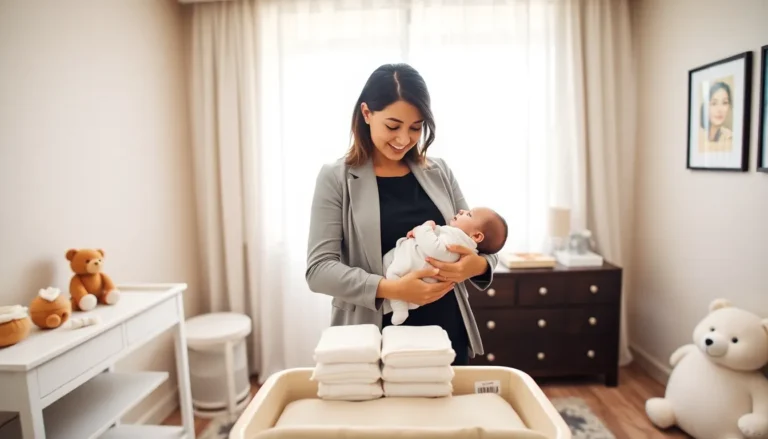Table of Contents
ToggleExperiencing pain in the lower left abdomen can be a concerning symptom for many women. This discomfort can stem from various causes, ranging from mild issues to more serious conditions. Understanding the potential reasons behind this pain is crucial for timely diagnosis and treatment.
From menstrual cramps to gastrointestinal disorders, the sources of lower left abdominal pain are diverse. Women may also face unique health challenges, such as ovarian cysts or ectopic pregnancies, that warrant attention. By exploring these possibilities, individuals can better navigate their symptoms and seek appropriate medical advice when needed.
Understanding Pain Lower Left Abdomen Female
Pain in the lower left abdomen of females can arise from various conditions. Recognizing these causes plays a crucial role in determining the appropriate response.
Common Causes
- Menstrual Cramps: Many women experience cramping in the lower abdomen during their menstrual cycle. This discomfort typically subsides after a few days.
- Gastrointestinal Disorders: Conditions such as irritable bowel syndrome, diverticulitis, and constipation affect many individuals. Symptoms may include sharp or dull pain, changes in bowel habits, or bloating.
- Ovarian Cysts: These fluid-filled sacs on the ovaries can cause varying levels of discomfort. They may lead to pain during ovulation or intercourse, depending on their size and rupture state.
- Ectopic Pregnancy: This serious condition occurs when a fertilized egg implants outside the uterus, often in a fallopian tube. It may cause severe abdominal pain and requires immediate medical attention.
When to Seek Medical Attention
Prompt evaluation is essential for persistent or severe pain. Specific indicators necessitating medical advice include:
- Acute agony: Sudden, intense pain may signal a severe issue.
- Fever: Fever accompanying abdominal pain could indicate infection.
- Nausea and vomiting: These symptoms can exacerbate discomfort and suggest underlying concerns.
- Changes in menstrual patterns: Irregularities alongside pain should be discussed with a healthcare professional.
Understanding these potential causes and symptoms aids in recognizing when professional medical advice and assistance are necessary.
Common Causes of Pain Lower Left Abdomen

Pain in the lower left abdomen can stem from various conditions. Understanding these common causes is essential for identifying the appropriate course of action.
Gastrointestinal Issues
Gastrointestinal issues frequently contribute to lower left abdominal pain in women. Conditions such as:
- Irritable Bowel Syndrome (IBS): IBS can cause cramping and discomfort, along with changes in bowel habits, such as diarrhea or constipation.
- Diverticulitis: Diverticulitis involves inflammation of the diverticula, small pouches that can form in the colon. Symptoms include sharp pain, fever, and changes in bowel movements.
- Constipation: Severe constipation may lead to significant cramping and discomfort, primarily in the lower abdomen.
- Gastroenteritis: Infections or inflammation of the stomach and intestines can cause pain, diarrhea, vomiting, and fever.
Reproductive Health Concerns
- Ovarian Cysts: These fluid-filled sacs on the ovaries can become painful, especially during ovulation or sexual intercourse.
- Ectopic Pregnancy: An ectopic pregnancy occurs when a fertilized egg implants outside the uterus. This condition often results in acute, severe pain and requires immediate medical attention.
- Endometriosis: In this condition, the tissue similar to the uterine lining grows outside the uterus, causing debilitating pain, particularly during menstrual periods.
- Pelvic Inflammatory Disease (PID): PID involves infection and inflammation of the female reproductive organs, leading to significant pain, fever, and abnormal discharge.
Symptoms Associated with Pain Lower Left Abdomen
Pain in the lower left abdomen can accompany various symptoms, indicating different underlying issues. Recognizing these symptoms aids in determining the need for medical attention.
When to Seek Medical Attention
Seek medical attention promptly if experiencing any of the following symptoms:
- Severe Pain: Intense or worsening pain may signal a serious condition.
- Fever: A high fever combined with abdominal pain can indicate infection.
- Nausea and Vomiting: Persistent nausea or vomiting alongside abdominal pain warrants evaluation.
- Changes in Bowel Habits: Significant alterations in bowel movements or abnormal stools can signify gastrointestinal issues.
- Abnormal Bleeding: Unexpected vaginal bleeding or changes in menstrual patterns necessitate immediate consultation.
- Dizziness or Fainting: Feeling faint may suggest an internal problem requiring urgent care.
Home Remedies and Management Options
Consider these home remedies and management options for mild pain relief:
- Heat Therapy: Applying a heating pad can ease cramping and discomfort.
- Hydration: Drinking plenty of fluids aids in relieving constipation and gastrointestinal distress.
- Diet Adjustments: Incorporating fiber-rich foods may improve digestion and alleviate symptoms.
- Over-the-Counter Medications: Non-prescription pain relievers like ibuprofen or acetaminophen can help reduce pain.
- Gentle Exercise: Light physical activity, such as walking, can relieve gas and bloating.
These strategies may provide temporary relief; however, persistent or severe symptoms require professional evaluation.
Diagnostic Approaches
Diagnostic approaches for lower left abdominal pain in females involve a systematic evaluation to identify the underlying cause. Health professionals often use several methods to ensure accurate diagnosis.
- Medical History Review
Medical history provides essential insights into symptoms, duration, and medical background. Healthcare providers ask about menstrual cycle regularity, gastrointestinal symptoms, and previous medical conditions.
- Physical Examination
Physical examinations assess the abdominal area for tenderness, swelling, or masses. Physicians may perform specific maneuvers to elicit pain or discomfort to narrow down potential causes.
- Laboratory Tests
Laboratory tests offer critical information about the body’s internal processes. Blood tests can check for infections, inflammation markers, or hormonal imbalances. Urinalysis helps detect urinary tract infections or kidney issues.
- Imaging Studies
Imaging studies provide visual assessment of internal structures. Ultrasound is commonly used to evaluate ovarian cysts, ectopic pregnancies, and other abnormalities. CT scans or MRIs may also be utilized for a more detailed view of the abdomen.
- Endoscopy
Endoscopy allows direct visualization of the gastrointestinal tract. This method helps diagnose conditions like diverticulitis or inflammatory bowel disease (IBD) when indicated.
- Laparoscopy
Laparoscopy serves as a minimally invasive procedure for direct examination and possible treatment. It allows for the identification of issues like endometriosis or pelvic inflammatory disease.
By utilizing these diagnostic methods, healthcare professionals can accurately determine the cause of lower left abdominal pain, guiding appropriate treatment options.
Lower left abdominal pain in women can stem from a variety of causes that range from benign to serious. Recognizing the symptoms and understanding when to seek medical help is crucial for effective management. While home remedies can provide temporary relief for mild discomfort, persistent or severe symptoms warrant professional evaluation. By identifying the underlying issues through proper diagnostic methods, healthcare providers can offer tailored treatment options. Staying informed about potential causes and symptoms empowers women to take charge of their health and seek timely care when needed.








